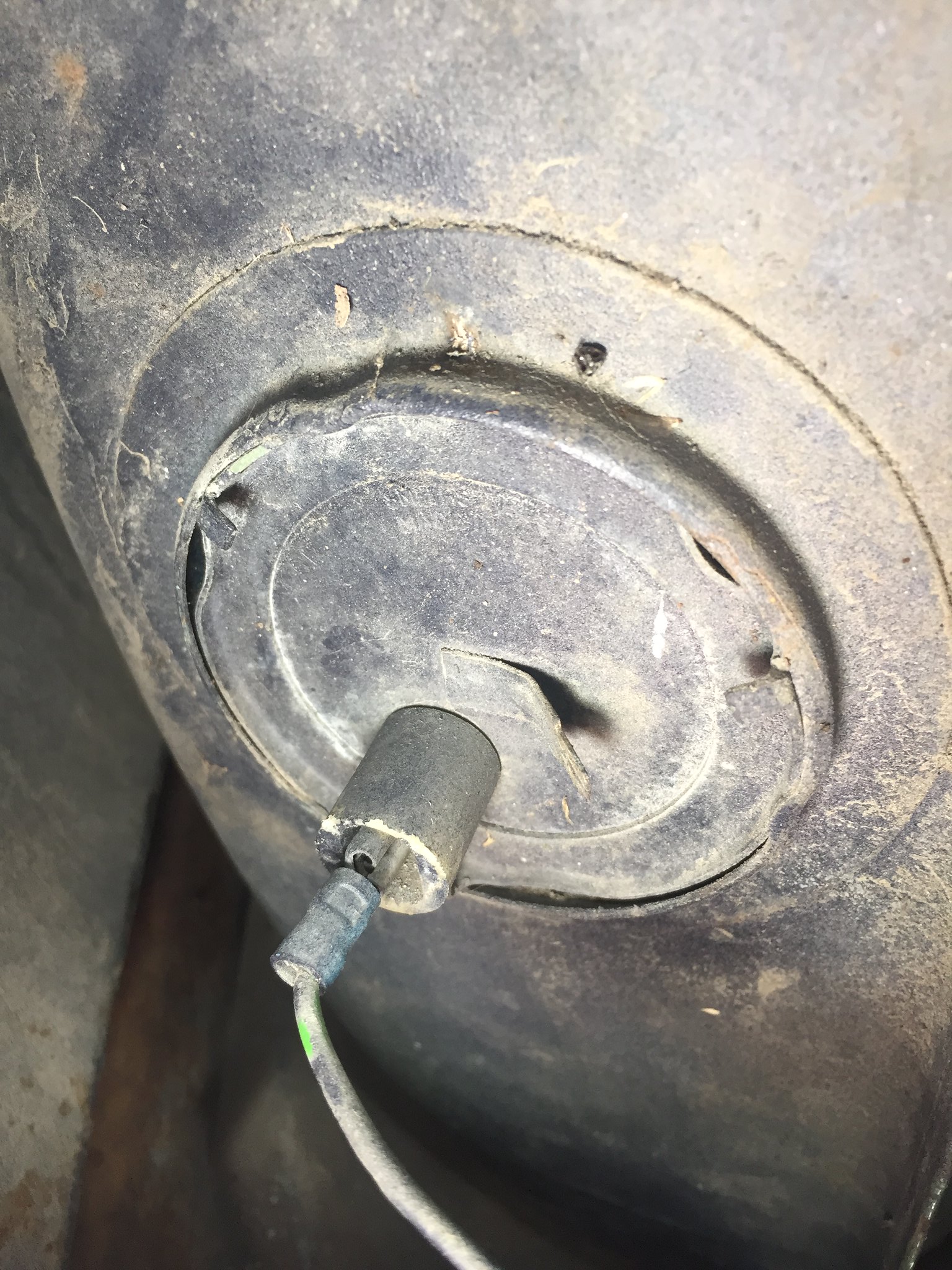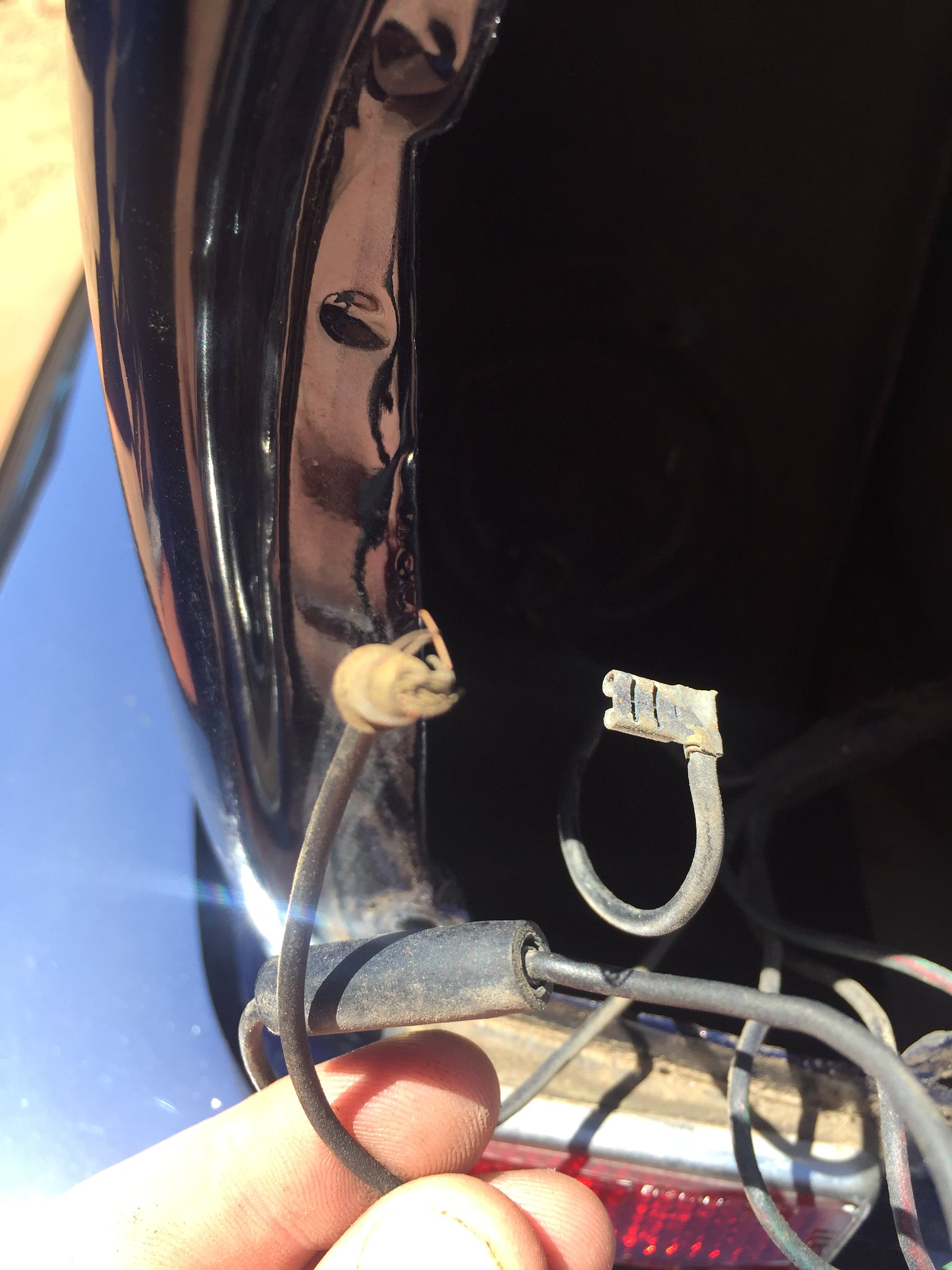The original senders have a plastic float on the end of a wire arm. It’s not unknown for the floats to leak and fill with petrol, so they no longer float on the surface.
Some folks have had some success draining and repairing the float. However new senders are available and they usually come with a more modern closed cell foam float.
However it certainly makes sense to check electrical wiring and switches before trying to fix a sender.
Remove the rear light on the faulty side and check the sender is connected properly, and grounded too.
As you work around this car you will soon pick up advice given frequently here which is dissasemble, clean, lube, and reassemble every electrical connector you find.
Snoops car is a series 11 so the fuel sender hides behind a round panel in the rear wheel arch, secured by three self tappers. There’s a drain plug under the valance to drain the old petrol out.
Robin,
There was a recent thread about a Series II XJ6 where the fuel quantity senders were located at the rear of the fuel tank like the Series III XJ6s and not at the front as you describe. This was the way it came from the factory and not a modification. I looked this up in my Series II XJ6 Parts Catalogue and was surprised to see that the earlier Series II cars had the sender in the front and the later Series II cars had them at the rear. So where the senders are located in a Series II car depends on when it was built.
Paul
And perhaps fuel injected versus carburetors?
Cheers
DD
Doug,
It is quite possible that the fuel quantity sender location in a Series II car has something to do with fuel delivery, but maybe it’s not so hard and fast as that. 
I live in the USA and know about the USA market Series III cars. I have been surprised before about configurations of cars delivered to other markets, like another recent thread about Series III XJ6 with a 3.4L engine with carburetors. I had no idea those cars existed. 
As far as the fuel quantity senders in Series II cars, maybe they were in the front from the factory, or maybe they are in the rear from the factory, or maybe a prior owner replaced the Series II fuel tanks with them at the front and installed Series III tanks with them at the rear.
Luckily it is easy to remove the tail lights to find out. 
Paul
Wasn’t aware that that was a possibility from the factory, you live and learn…then you die 
Well I can confirm the senders are at the back behind the tail light, so easy to check and I found the wire off the sender - back on and all working. Mine is an 08/77 build date with carbs if anyone’s trying to work out what fuel senders went where - I highly doubt this vehicle has had the fuel system modified, so would be original IMO.
 Untitled by Gavin Gregory, on Flickr
Untitled by Gavin Gregory, on Flickr
Also found a couple of wires back there I can’t account for - as per the pic below these 2 wires are also stuffed in behind the tail light. The spade terminal is slightly smaller than a normal one and the other wire looks like an earth - any ideas?
 Untitled by Gavin Gregory, on Flickr
Untitled by Gavin Gregory, on Flickr
Finally a bit of a dumb question sorry - I have a manual heading my way but won’t be here until next week - Where do the fuel pumps live - or more to the point - how do I access them? I’ve found the wiring in the boot and checked it - the side not working is getting 12 volts when the switch is pressed but the resistance of the pump is very high compared to the unit that runs. The wiring to the working pump looks much newer so I’m guessing this side was replaced at some point. Just need to get the stuffed one out now but haven’t figured out how to access it…
TIA - Gav.
Another question - what was the original radio used in these vehicles? PO has installed a ‘retro’ radio but it’s pretty awful. Don’t need Bluetooth in it, so was thinking of going back to an old radio/tape deck if I could find one in half decent condition.
**
Both carbs and FI have safety features that prevents the pumps from running, Gavin - except in ‘crank’ and while the engine is running…
The changeover switch has two separate functions; switching power to the selected pump - and switching fuel gauge to the selected tank. Which grounds the gauge through the tank unit…
Since you solved the non-reading gauge; test the pump by selecting ‘D’ and turn key to ‘crank’. The engine won’t crank - but you should hear the selected fuel pump running…
Frank
xj6 85 Sov Europe (UK/NZ)
**
Of those stray 2 wires. The one with a 90 degree connector looks like it was the ground wire for the fuel tank sender. The sender would have had a matching spade on it at one time, on that strip of metal that is welded to it and curves outward - now not apparently doing anything. Its terminal tag for the connector is broken off.
As the tank is metal and is grounded to the bodywork of the car by its mounting bolts the sender is working anyway.
Not sure about the other wire. Is the lighting unit grounded with a wire (it should be) or has that also been relying on grounding through the mounting screws?
The RHS pump runs fine with the ignition switched on while still in park, and I get 12 volts when it’s switched over to the LHS. Not sure what is or isn’t supposed to happen, but it’s no dramas and makes it easy to diagnose. The faulty fuel pump is also showing over 1000 ohms so pretty well open circuit so I know it’s the pump. Electrical stuff I can do, I’m an Industrial Electrician by Trade and do engine control (on large diesel generators) for a living. 
Ah - good points there thanks. Will check both those things. 
So can someone tell me how to pull a pump out while I’m waiting for the manual to arrive? TIA
Gavin,
have you opened the compartment behinde the spare wheel well? A late carbed SII car should have immersed fuel pumps, i.e. the pumps are inside the tanks and I suppose it is not quite a walk in the park to change them. But someone might have retrofitted the older external pumps that are usually mounted inside this compartment.
Even while you don’t have the ROM yet, you can check the original equipment of your vehicle here https://www.jaguarclassicparts.com/catalogue/xj6-ser-2-daimler-sov-ser2/fuel/#p=70 on p. 1M 02R and 03L.
Still, with the first issue solved so easily there seems to be at least a chance that the fuel pumps malfunction is also caused by a simple electric issue. I’m not quite sure what you mean by you get 12 V if you switch to left. Where did you measure? At the switch or at the tank. And if you say you had 1000 Ohms at the fuel pump, how did you measure if you don’t know where the pumps are? Have you already checked the electric connectors to the pumps? You find the submerged pump, if you remove the wheel and the circular cover plate in the wheel well.
Power runs through the fuel tank changeover switch in the dashboard and this one, far from being bullet proof, might be broken as well. With one pump working you know that there must be power to the switch. The right hand fuel tank works unswitched. This seems to be the one working in your car. So you have a serious chance that the switch is the culprit. Then you’ll have to check whether, depending on position, the white/purple and the white/green wires are powered. - Since you have to pull the small cover with the two switches left to the clock anyhow, you can just as well cross-check by changing the switches - of course, this makes sense only if the other switch is known to work.
Good luck and keep us posted
Jochen
75 XJ6L 4.2 auto (UK spec)
Thanks - yeah they are the submerged type now I’ve looked a little harder. The electrical connection to each pump is in the boot behind the side panels with the wires going through the panel into the tank area - process of elimination while fault finding - found these connectors, but not the pumps they were attached to.  - pulled the connector and I get 12 volts there when the switch is changed to the LHS tank. Resistance check was done with the connector disconnected checking the wires to the pump itself - getting 1000 ohms. The RHS pump measures 9 ohms which is around 1.3 amps which is about right for a fuel pump like this.
- pulled the connector and I get 12 volts there when the switch is changed to the LHS tank. Resistance check was done with the connector disconnected checking the wires to the pump itself - getting 1000 ohms. The RHS pump measures 9 ohms which is around 1.3 amps which is about right for a fuel pump like this.
Happy with the wiring just need to free the pump now - found the plate behind the wheel thanks - there the main feed hose comes through this and up into the body, so happy to follow that down the rabbit hole. Won’t be today though as I have other things to do, but will try this during the week. Don’t really want to take it too far without both working. If ones dead, I’m sure the other isn’t far behind it, so may buy 2 new ones and be done with it. Will call my parts supplier this week and see what he can do for me. 
![]()
![]()
![]()
![]()
He he - behave yourself. 

teaser excerpt from S2 FSM…on the submerged pump, ( pic may be “early” pump)
I would only replace the failed pump
you will have other chances to fire the parts cannon
there are no OH instructions for submerged, FSM says replace
Thanks for that - looks pretty straight forward. Also looks like the pumps are standard Bosch (Or similar) low pressure in tank pumps after Googling those part numbers. Will see exactly which type I need once I have it out. 
**
Failed pump for sure, Gavin…
Frank
xj6 85 Sov Europe (UK/NZ)
**
